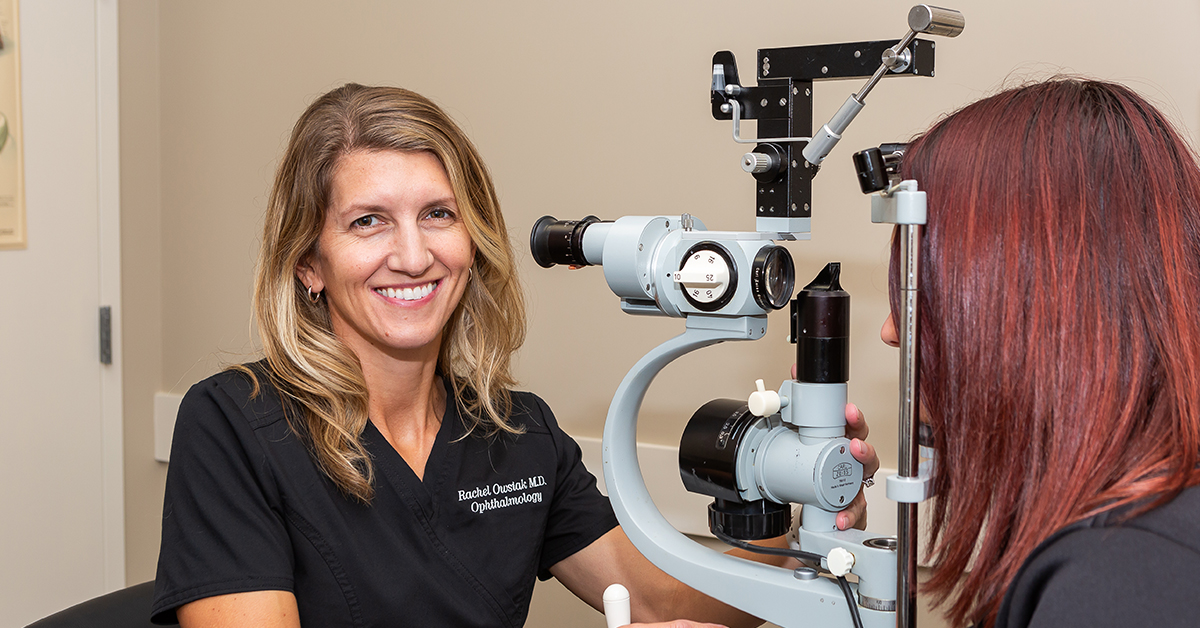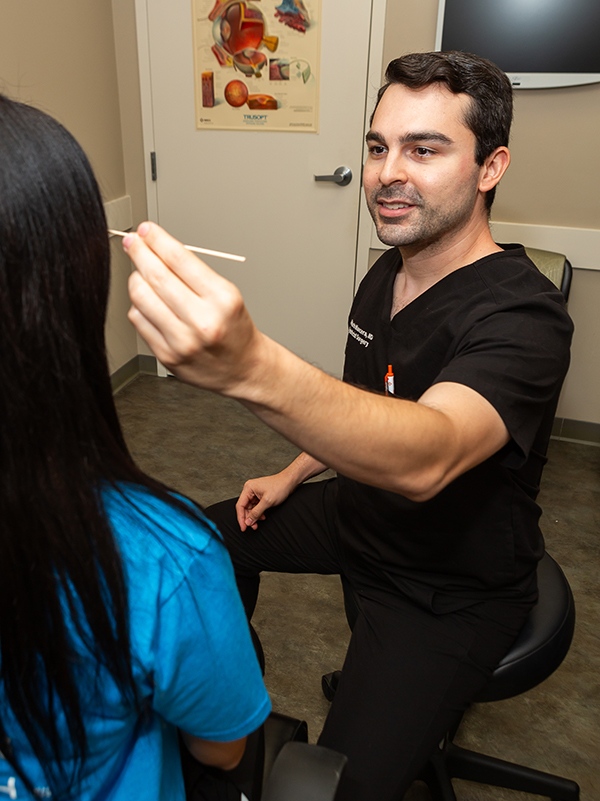

Jordan Pysz / iFoundMyDoctor.com
Dr. Owsiak specializes in laser cataract surgery and minimally invasive glaucoma surgery but says she “does a little bit of everything” at the institute’s Riverview and Sun City Center clinics.
For more than 40 years, the physicians and staff at Florida Eye Specialists & Cataract Institute have devoted themselves to providing excellence in eye care. Their services range from traditional eye exams to sophisticated laser surgery. The institute recruits the most skilled professionals, including Rachel R. Owsiak, MD, who recently joined the team. Dr. Owsiak is a comprehensive ophthalmologist who treats a variety of eye diseases as well as basic ocular conditions. Dr. Owsiak graduated magna cum laude from Hope College in her native Michigan, earned her medical degree at Loyola University Chicago Stritch School of Medicine and completed an ophthalmology residency at Beaumont Hospital in suburban Detroit. She spent the past 10 years practicing in Tennessee and Missouri before joining Florida Eye Specialists & Cataract Institute. Dr. Owsiak first became passionate about ophthalmology and patient care early in her medical training. “Ophthalmology is a unique field in which doctors can tell a lot about the health of patients through their eyes,” she relates. “It was interesting to me in terms of finding and treating medical conditions and improving patients’ overall health by examining the eyes. It also has a surgical aspect. The combination of the two got me excited about pursuing ophthalmology as a career.” Dr. Owsiak does “a little bit of everything” at the institute’s Riverview and Sun City Center clinics. While she specializes in laser-assisted cataract surgery and minimally invasive glaucoma surgery (MIGS), Dr. Owsiak also provides primary eye care. “Primary care includes everything from routine diabetic eye exams to treating more urgent issues, such as foreign bodies in the eyes and iritis, which is inflammation of the colored part of the eye (iris),” the doctor details. “It also includes monitoring chronic eye disorders such as macular degeneration, glaucoma and dry eye disease so those conditions don’t get worse. “I diagnose and monitor all of these conditions, but if the patient requires specialized care, I refer him or her to one of the specialists on staff.” Dr. Owsiak believes open communication helps patients become an integral member of their eye care team. She takes the time to listen to patients, performs thorough assessments and develops personalized treatment plans. She also educates patients about their eye conditions and answers any questions they may have. “Typically, if we’re managing a chronic condition, we see patients on a routine basis,” Dr. Owsiak relates. “I enjoy explaining their condition, why they need treatment and how treatment helps. I believe that helping patients understand what’s going on with their eyes makes them more motivated to continue treatment and come in for follow-up visits.”
Surgical Specialties
Cataracts are a clouding of the lens caused by a buildup of protein deposits. The only treatment is surgical removal of the lens, typically performed on one eye at a time, a week or two apart. Each procedure takes only a few minutes and starts with the breakup and removal of the lens. Then, a synthetic replacement known as an intraocular lens, or IOL, is implanted. IOLs come in various focusing powers to correct a variety of refractive issues. “Treating cataracts with cataract surgery is probably the most rewarding aspect of my work because there’s usually a significant improvement in the patient’s vision in a short period of time,” Dr. Owsiak observes. “And that is life-changing for some patients. But treating the other eye issues is also very satisfying.” According to Dr. Owsiak, laser-assisted surgery is an excellent option for treating astigmatism, which is an imperfection in the curvature of the eye that leads to blurry vision at all distances. “Using a laser for cataract surgery can also reduce the amount of time we’re actually in the eye doing surgery,” the doctor relates. “The laser performs several steps of the surgery that make the removal of the cataract more efficient. But it mainly allows us to treat the irregular shape of the eye to correct the astigmatism, improve the patient’s quality of vision and reduce the need for glasses following cataract surgery. “Manufacturers are constantly coming out with new IOL options, but there have long been special lenses called toric lenses that correct astigmatism. We also have premium multifocal IOLs that correct for both distance and near vision. There are also lenses that provide patients with distance and intermediate vision, called extended-depth-of-focus lenses, as well as trifocal lenses that correct for near, intermediate and distance vision. “These lenses can be a great option that allow patients to significantly reduce their dependence on glasses following surgery and see clearly at multiple distances.” Physicians with the institute perform tests to determine whether patients are candidates for laser-assisted cataract surgery and the premium IOL options. Advanced technology allows the doctors to get the most accurate eye measurements possible. “We also spend time talking with patients to ascertain their goals for cataract surgery and their motivation for reducing their need for glasses,” Dr. Owsiak notes. “We use information from both the evaluation and the discussions to choose the best candidates.” Dr. Owsiak also specializes in a type of minimally invasive glaucoma surgery to implant a tiny tube into the eye’s drainage system that reduces the blockage of fluid. The clog could otherwise raise fluid pressure inside the eye, which can damage the optic nerve and cause vision loss, both hallmarks of glaucoma. The tube, called the iStent inject®, is typically placed during cataract surgery. “If the patient’s glaucoma is severe, it may require more extensive surgery, for which I refer patients to one of the glaucoma specialists on staff,” Dr. Owsiak states. “But often, patients do well with eyedrop therapy or MIGS and routine monitoring, so most never need a major surgery. “MIGS has expanded treatment options for glaucoma patients to help prevent vision loss due to the disease. “It also helps reduce the number of eyedrops patients must use to treat their glaucoma. It is a nice option for patients who are already undergoing cataract surgery.”


Jordan Pysz / iFoundMyDoctor.com
Dr. Mancera is an oculofacial plastic surgeon who specializes in a range of cosmetic procedures.
Facial Aesthetics
Among Dr. Owsiak’s colleagues in the Sun City Center clinic is oculofacial plastic surgeon Norberto Mancera, MD. Florida Eye Specialists & Cataract Institute offers a range of cosmetic procedures for the eyes and face. Dr. Mancera is one of the specialists providing these services, one of which is eyelid surgery. “There are several conditions that can affect the aesthetics of the eyes,” Dr. Mancera informs. “One is excess skin on the upper eyelids called dermatochalasis. For this, we do a procedure called blepharoplasty to incise the excess skin. It is the most common surgery we perform on the eyelids.” During blepharoplasty, an incision is made in the eyelid crease so no visible scar remains after surgery. The surgeon then removes the excess eyelid skin. The result is an improvement in peripheral vision and a rejuvenation of appearance. The patient looks more alert and pleasant. Medicare and other insurance programs may cover the cost of blepharoplasty if the patient’s visual field is obstructed by the excess skin. “If people look in a mirror and see the skin of the upper eyelids approaching their eyelashes, that may well represent a loss of their visual field,” Dr. Mancera asserts. “We measure vision loss by performing a visual field test. Peripheral vision is first measured with the eyelid in its natural position. Next, the eyelid is taped up and the vision is rechecked. “If there is a difference of 12 degrees or more between the tests, the eyelid condition is considered a functional problem and is typically covered by insurance.” Another procedure offered by Dr. Mancera is ptosis repair, which corrects droopy eyelids. “Sometimes, as people age or as a result of another condition such as mechanical trauma, the eyelid will droop on one or both sides,” the doctor reports. “Those droopy eyelids can make people appear old, tired or even mean. Ptosis repair involves tightening the muscles that lift the eyelid, which gives the eyes a brighter, more open appearance. “During the procedure, we make an incision in the eyelid crease, similar to what we do with blepharoplasty, but there is no skin removal with ptosis surgery. We determine which muscle is loose and then tighten it with a stitch.” Dr. Mancera also performs lower lid blepharoplasty, a procedure designed to remove bags under the eyes as well as excess skin on lower eyelids. This procedure is done through a small incision inside the eyelid to prevent scarring. “Lower lid blepharoplasty involves removing the little fat pads that cause the bags under the eyes,” the doctor explains. “We also tighten the surface of the skin so the patient has a more refreshed look without the bags and shadows under the eyes. “Also for the eyelids, we offer carbon dioxide laser resurfacing. The laser causes microtrauma to the skin, which revs up collagen production to tighten the skin. The laser also reduces fine lines and wrinkles, not just around the eyes but on the entire face. “We often use this to remove ‘smoker lines,’ those tiny wrinkles between the nose and upper lip that some people get even if they aren’t smokers. They are usually caused by aging.” Dr. Mancera, who also practices at the institute’s Brandon and Plant City clinics, performs many other facial cosmetic surgeries, including eyelid malposition surgery, forehead lifts, brow lifts, lip lifts and face-lifts, which include lifting the neck.
Neurotoxins and More
In addition to the surgical procedures, oculofacial plastic surgeons at Florida Eye Specialists & Cataract Institute provide multiple nonsurgical services to improve the appearance of the eyes and face. These include injections of neurotoxins such as BOTOX® Cosmetic and XEOMIN® as well as facial fillers. “When people animate their face, such as raising their eyebrows or furrowing their brow when upset, it causes active lines to form on the face,” Dr. Mancera asserts. “By forming those lines continuously throughout the day, the wrinkles become much deeper and more permanent. “BOTOX Cosmetic and XEOMIN are injected into the different muscles of the face that are responsible for those wrinkles. These neurotoxins temporarily paralyze those muscles, which smooths out the lines and wrinkles and prevents permanent wrinkles.” Neurotoxin injections are typically used on forehead lines, the crow’s feet that form on the outer corners of the eyes and the smile lines called “the 11s” between the eyebrows. Another injectable procedure offered by Dr. Mancera is the facial filler. Some common fillers used at the institute are JUVÈDERM®, VOLUMA™ and Restylane®. Many fillers contain hyaluronic acid, a substance found naturally in the body that helps restore volume and hydration to the skin. “Fillers are used in many areas of the face, most specifically in the lip area to provide augmentation, the nasolabial folds and the marionette lines that extend from the corners of the mouth down toward the chin, as well as in the cheeks,” Dr. Mancera discloses. “By performing these injections, we volumize the face, which results in a more youthful appearance. “Filler injections last anywhere from 12 to 18 months. They are relatively painless and require minimal downtime.” The carbon dioxide (CO2) laser is one of the energy-based devices used at the institute. Another is intense pulsed light, or IPL. “IPL uses energy in the form of high-intensity light at various wavelengths to treat pigmentary issues on the face,” Dr. Mancera describes. “These issues include sunspots; melasma, which are areas that are darker in color than the natural skin tone; and rosacea, a condition that causes redness of the face. Intense pulsed light even helps relieve symptoms of dry eye disease. “While not a laser, IPL works on the same principles. Light is absorbed into specific skin cells, where it is converted into heat energy. The heat damages the walls of targeted blood vessels and breaks up pigment cells. The affected vessels and pigment cells then rise to the surface of the skin, where they fade or are carried away by the lymphatic system.”







Leave a Reply